|
Cambridge Junction Covered Bridge Opened to Light
Traffic.
Jeffersonville, July 9, 2004 - Light traffic flows again over the Junction Bridge while
discussions continued on the acceptance inspection results.
Because the acceptance inspection required to reopen
the Cambridge Junction Bridge to traffic raised a question, it had been decided to open the bridge
for the opening ceremony only, the town to replace barriers at the conclusion of the ceremony.
See "Inspection Iffy" article below.
A last minute decision allowed the bridge to remain
open. Said William Flanders, VAOT Site Engineer in an email: "The area in question was
reinforced by the installation of hardwood blocks. This installation facilitated the bridge to remain
open while discussions occur as to a permanent solution."
Cambridge Junction Covered Bridge Opened
[VT-08-02]
by Joe Nelson
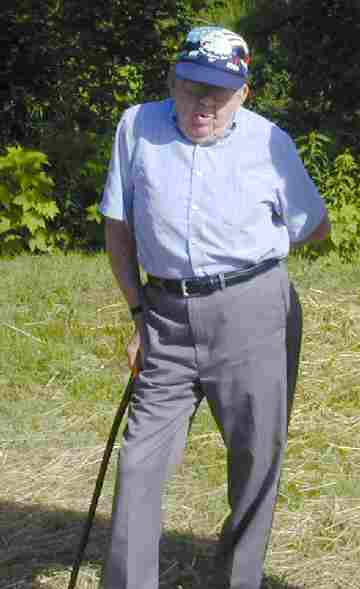 |
| Mr. Wendell (Stub) Wells |
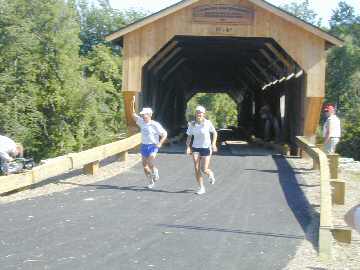 |
|
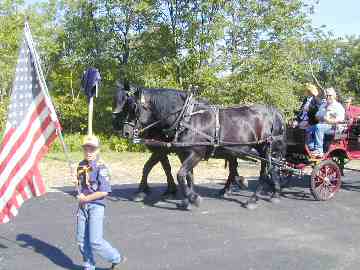 |
|
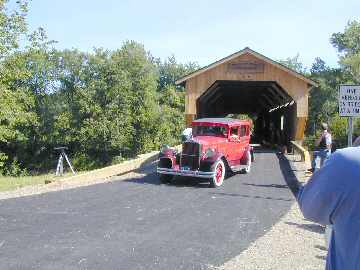 |
|
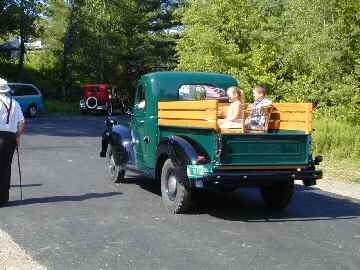 |
| Photos by Joe Nelson, July 4,
2004 |
Cambridge Junction Vermont, July 4, 2004 - At 8 a.m., on what turned out to be a
perfect
day for a celebration, the selectmen moved the Jersey Barriers away from the portals of the
Cambridge Junction Bridge. The Barriers were moved back at the close of the ceremony. [See the
following article. - Ed.]
The ceremony to celebrate the completion of the
rehabilitation of the Junction Bridge, also known as the Poland Bridge, was opened by town
resident William McKone, active in town affairs and member of the Cambridge Historical
Society.*
A team of horses pulling a carriage loaded with
celebrants was first to cross the bridge, preceded by a color guard of local two Scouts. The horses
were followed by two antique cars and a motor cycle, all spaced out so that only one vehicle
loaded the bridge at a time.
Kicking off the ceremony, McKone said: "The
Cambridge Junction Covered Bridge has
been rehabilitated and it's a beautiful job . . . its's been out of service for some ten years, now we
have restored it and we hope it will be preserved for the future, its always the question of
respecting the bridge and reading the signs . . . so there isn't any damage to the bridge in the
future. I hope every body will enjoy it."
McKone went on to describe plans for the environs of
the bridge. The town's green way is
adjacent to the portal of the bridge, following the old railroad right-of-way. "The green way is
intersecting with the bridge and it's going to be extended so there will be quite a recreation
complex . . ." McKone said. "our intention is to use the sidings from the old Cambridge Junction
railroad station to create a park, which we hope to name for Senator Jeffords who got us the
money to restore this bridge as part of his national historic covered bridge preservation bill of
some years ago.
"The state was kind enough to put together a sign for
us commemorating this [bridge] and
giving some information. I'm going to ask Stub Wells, who has been a long time resident to unveil
the sign and say a few words about the bridge."
In the gathering of about 100 people were Senator
Bartlett and Representative Rich
Westman of the Vermont Legislature, town selectmen Dana Sweet, Frank Hutchins and Brad
Blaisdell, and VTrans site engineer for the bridge William Flanders.
McKone introduced Wendell (Stub) Wells and Kate
Westberg. Ms. Westberg, just
graduated from St.. Michael's College, did a journalism project on covered bridges. Stub Wells
helped her with her research and provided her with some photos that went into the booklet she
produced.
Said Kate Westberg: "The last time I was here, this
isn't what the bridge looked like, so it's
beautiful to finally see [it in this condition]. Stub Wells invited me, a stranger into his home and
shared his knowledge and stories and history with me. This is one of the last copies [of the
booklet] and I am giving it to you for keeping the Cambridge Junction [history alive]."
Stub received the booklet with thanks. The historic
site sign was unveiled with some
difficulty, as the masking blanket had been secured with duct tape against the breezes.
Said Stub Wells, "Bill has asked me to say a few
words here, but I'm going to go back
quite a ways, I'm going to turn the pages back on the old calendar eighty-five years. That is when
I was brought up in Belvidere . . ."
Belvidere and Waterville are situated along the North
Branch of the Lamoille River and
because of this, travelers didn't have to go far before crossing a bridge. When stub passed through
an "arch" bridge he would wonder "What is that round thing along the side of the bridge?"
Stub was told, "Well, that is half of a wheel that holds
up the bridge."
"I asked why isn't it underneath to hold up the bridge
[and only] on top? He never
explained to me why."
Stub described his travel through the bridges: "Then
we came down to Belvidere Junction.
We lived right at the end of the covered bridge and there, when the horses went through there,
you could hear clippity-clop, clippity-clop, and I heard the same sound today with these horses. It
was a wonderful feeling.
"Then you come down to Waterville and you entered
another covered bridge. From
Waterville then you came to the Town of Cambridge [and] the Marsh, what was called the
George Marsh Bridge, I have traveled through many of these, many, many times.
"From the Marsh bridge we always came to Junction
Bridge, better known as the Poland
Bridge. Lots of times we had to stop when we came out here because back in those days they had
three passenger trains that came up from Burlington. They had freight trains, they had milk trains.
Then you had your trains from St. Johnsbury and Swanton. It was just fun to set here and watch
these trains.
"But this bridge, back in the middle 1800s, the Town
of Belvidere, the Town of
Waterville, asked the selectmen of the Town of Cambridge if they would build a bridge here at
Cambridge Junction, because they had to go down the other road to the [Bakersfield Road] and
into the village and back up here with their lumber and whatever they put into boxcars. And it's
two and two-tenths miles from the bend here, way around back to the bridge.
In 1885 Mr. Poland was retired from Washington as
the congressman and then he owned
land in Waterville and Belvidere, he owned the piece of land on the right as you cross the bridge.
The selectmen of Belvidere and Waterville hired him, he was a lawyer, and he sued the Town of
Cambridge and won the suite. But the Town of Cambridge didn't build the bridge until 1887.
"But Mr. Poland never lived to see this built, because
he died right here of a heart attack
in this little field.
"And then there were the years I started working for
the McGovern store and I delivered
feed to all the farmers up through here and I crossed this bridge about four or five times in a
week. I always liked to see the design of them.
"I don't think there's anything else I can tell you
about these bridges, but I always loved
them in the olden days when I first started courting the girls."
Mr. Wells agreed, yes, he may have very well have
started the tradition that covered
bridges are kissing bridges.
* [Mr. McKone is also a member of the Vermont Covered Bridge Society but was not
representing the VCBS in this affair.- Ed.]
Cambridge Junction Bridge Inspection Results Iffy.
By Joe Nelson
Cambridge Junction, July 3, 2004 - The acceptance inspection of the Poland Bridge took
place
on Wednesday, June 30, with acceptance assured. However word was received today that further
investigation was needed due to a distortion of the bearing plates that receive the arches at the
bridge abutments.
A satisfactory inspection is necessary for the bridge to
be accepted into the state highway
system and open to traffic. With the bridge closed, the planned opening ceremony for July 4
would have to take place without access to the bridge.
According to Jim Ligon, Poland Bridge construction
supervisor for Alpine Construction,
Bill Flanders, the AOT resident engineer, called him late Friday morning and informed him that
someone from AOT had determined 11th hour that the bearing plates behind the arches are bent
and the opening ceremony cannot take place without correcting that.
No plan was submitted on the correction desired,
other than some type of a hardwood
shim, Ligon said.
"It's unfortunate that this errant snag occurred late on
a long holiday weekend when both
the State of Vermont and the contractor are out until Tuesday," Ligon said.
Said Ligon in an email to this writer, "The bearing
plates are 1" steel, with a large gusset
welded in the center to accept the through bolts. The high heat produced during that welding
process of thick steel made the large plates curl very slightly. That issue was addressed a year ago
when the plates were delivered to the project, with no corrective action determined to be
required. My interpretation of the conversation with Bill Flanders was that someone was
concerned that the plates had bent due to the loading of the arch members."
With the inspection team unreachable, local
authorities decided to open the bridge for the
ceremony, allowing only one vehicle access at a time. The barriers would be replaced pending the
outcome of the inspection.
|
 Joe Nelson, P.O Box 267, Jericho, VT 05465-0267
This file posted July 5, 2004, revised July 16, 2004
Joe Nelson, P.O Box 267, Jericho, VT 05465-0267
This file posted July 5, 2004, revised July 16, 2004
 Joe Nelson, P.O Box 267, Jericho, VT 05465-0267
This file posted July 5, 2004, revised July 16, 2004
Joe Nelson, P.O Box 267, Jericho, VT 05465-0267
This file posted July 5, 2004, revised July 16, 2004